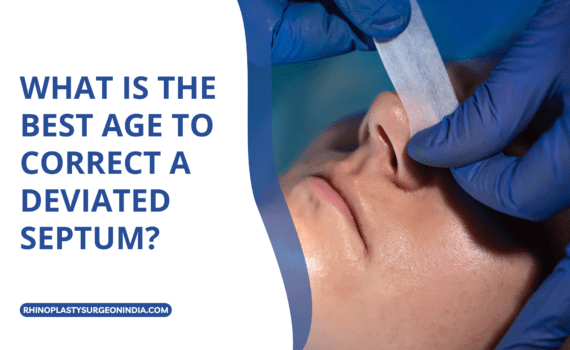
What Is the Best Age to Correct a Deviated Septum?
Deviated septum is a common problem and most people have little degree of deviation. The septum is a thin cartilage wall that divides the nostrils into two parts. Ideally, it should be in the center and divide the nostrils evenly to ensure a smooth airflow in the nose. But it is not so at all times.
Sometimes the septum can be deviated or perforated creating multiple functional and aesthetic problems such as
- One nostril appears larger than the other
- Blocked nostril
- Difficulty in breathing especially when doing strenuous work.
When the deviated or perforated septum starts to negatively impact the quality of life then it necessitates a deviated septum correction or a septoplasty by the best deviated septum surgeon.
Who can get a deviated septum surgery?
The nasal structures form fully by the average age of 16 years for girls and 18 years for boys and by this time the nasal septum also forms fully. Surgery before this can affect the growth of the nasal septum and hence affect the development of the facial structures. However, in cases when it is lifesaving, the deviated septum surgery can also be performed on children under the age of 16 by a good pediatric otolaryngologist or a deviated septum surgery. There is no upper age limit to getting a septoplasty procedure done.
What causes a deviated septum?
- Usually, it is congenital i.e., a person is born with it but later as a person ages,
- The deviated septum can also be caused because of injury to the nose during labor at birth.
- The deviated septum can be because of injuries from sports, fights, and accidents.
- When it is not treated it can get worse with ageing.
- In some cases, the changes in facial features during puberty which add more definition to the facial features can also lead to septum deviation.
Swelling and infection in the ideal nose can exacerbate the deviated septum with the passage of time as it can constrict the nasal channel and cause more obstruction. Board-certified best-deviated septum surgeons use functional septoplasty and aesthetic rhinoplasty to ensure a stable septum.
Symptoms of deviated septum
Most people don’t notice any discomfort because of the deviated septum but in some cases the mild to severe symptoms include
- Difficulty in breathing normally through the nose
- Preferring to breathe through one side of the nose
- Frequent nosebleeds
- Sinus infections
- Dryness in nostril or nostrils
- Snoring when sleeping
- The feeling of persistent nasal congestion or pressure or stuffy nose
- Preference to sleeping on one side as it makes breathing easier
- Chronic nasal discharge
- Facial pain
- Frequent and long-lasting headaches
When a child is affected by a deviated septum then the first line of treatment is to help manage the nasal obstruction. Only after the primary treatment has failed to solve the nasal breathing and sleep problems then surgery can be recommended for children.
What are the indications for deviated nasal septum surgery?
The deviated septum surgeon will first examine the nostrils using a nasal speculum device to see the placement of the septum and its impact. They will also ask about your sleep patterns, sinus issues, level of difficulty in breathing, etc. The following problems ask for a deviated septum surgery:
- Compressed nasal turbinates because of deviated septum. This leads to headaches and nasal congestion. Then the deviated septum presses down on the middle turbinate it causing blockages in the sinus opening and can cause regular sinus infection and thinning of the sinus wall. This is called the silent sinus syndrome.
- Bleeding from the nose: the deviated septum can lead to repeated bleeding because of the strain on the blood vessels that pass over the septum. This cannot be treated with medical or conservative treatment.
- Cosmetic reasons: the simple deviated septum correction can make a huge difference in the entire look of the face. Hence sometimes doing this surgery becomes necessary from a cosmetic point of view
Types of nasal septum deviation
Nasal septum deviation can be classified into two types
- According to anatomic deviation: The septum has two portions one is the cartilaginous part and the other is the bony part that joins to the skull. The deviation extends to both parts.
- According to functionality: this happens when the deviation is directed to one side (c-section deviation), or it is on both sides of the nasal cavities (S-shaped deviation).
Septoplasty or Septo-rhinoplasty procedure
These are usually surgical procedures that do not require prolonged hospital stay. The latest techniques used by best deviated septum surgeons in India reduce the risk of scarring, trauma, and post-operative complications. The entire procedure takes about 1-2 hours to complete and if rhinoplasty is included to change the shape of the nose, it might take a bit longer. The basic steps to the surgery include
Pre-operative preparation: Before the surgery, you may be required to undergo certain pre-operative tests and evaluations. You’ll be advised to stop taking medications that can increase the risk of bleeding, such as aspirin or nonsteroidal anti-inflammatory drugs (NSAIDs).
- Anesthesia: Septal perforation repair and the deviated septum surgery can be performed under local anesthesia with sedation or general anesthesia, depending on the complexity of the procedure and your surgeon’s preference. You’ll discuss this with your surgeon during the pre-operative consultation.
- Surgical procedure: The surgeon will access the nasal septum by making incisions inside the nostrils. They will carefully lift the mucosal lining of the septum to expose the perforation. The edges of the perforation are then trimmed and freshened, and a tissue graft is placed over the hole to close the perforation. In case of deviated septum correction, the surgeon will reshape, reposition, and straighten the septum to the desired position. If necessary, the surgeon might also trim a part of the septum. The graft can be taken from inside the nose (septal cartilage or mucosal flaps) or from another part of the body (e.g., ear cartilage or synthetic materials).
- Recovery: After the surgery, you will be monitored in a recovery area until the effects of the anaesthesia wear off. You may experience some discomfort, swelling, and nasal congestion for a few days. Your surgeon will provide instructions on how to care for your nose, including nasal irrigation, medication use, and activity restrictions. It’s important to follow these instructions closely to promote healing and reduce the risk of complications. During the recovery period, you should notify your surgeon if you experience any severe pain, excessive bleeding, or signs of infection.
Choice of cartilage for graft for deviated septum treatment and perforated septum treatment
The nasal grafts are almost always needed as part of deviated septum correction and to create a natural appearance of the nose. Artificial materials often do not give the natural drape and hence most deviated septum surgeons prefer using the patient’s own cartilage. Also using the patient’s own cartilage means the results will last forever. There are three types of cartilage used for the septum repair
- Rib cartilage: Rib cartilage rhinoplasty and reconstructive Septorhinoplasty is the most popular choice. The reason is that this material has the least rate of resorption, does not cause infections, and has low rates of complications. The rib cartilage is extremely resilient and strong to put up with the expansion and contraction that occurs while breathing. Another advantage is that this graft material is available in abundance and can be easily used in severe deformities for good structure support and dorsal augmentation.
- Nasal or the septal cartilage: This is taken from the nose but the drawback is that it can only be used for minor repairs. Using this also not possible in case of revision rhinoplasty because the septal cartilage might already be compromised. Nose cartilage can be easily harvested and does not cause any cosmetic or functional problems.
- Ear cartilage: This is another excellent choice for small grafts as it is not strong enough for major rhinoplasty reconstructions. The shape of the ear cartilage makes it an excellent choice for lower cartilage.
The long-term complications of using rib cartilage are the lowest. The biggest concern is wrapping but it can also now be easily corrected by dipping the graft in a solution before reshaping and resizing. Since the usual time for warping to happen is between 15 to 60 minutes of harvest, best-deviated septum surgeons usually wait out this period before reshaping the graft and positioning it.
The cost of deviated septum surgery
The cost of deviated septum surgery in India can vary depending on several factors, including the location, hospital or clinic, surgeon’s expertise, the type of cartilage used, and the complexity of the case. Additionally, the cost may also cover pre-operative consultations, anesthesia, medications, hospitalization (if required), post-operative care, and follow-up visits.
It’s difficult to provide an exact cost without specific details, but as a general guideline, the cost of septoplasty in India can range from approximately INR 30,000 to INR 1, 50,000 or more. However, these are approximate figures, and the actual cost may be higher or lower based on the factors mentioned above.
To get an accurate cost estimate for deviated septum surgery in India, it is recommended to consult with multiple healthcare providers, discuss your specific case, and obtain detailed cost breakdowns from them. Additionally, inquire about any potential additional costs that may arise during or after the surgery.
Remember to also check if your health insurance policy covers septoplasty or if any part of the procedure can be reimbursed. It’s advisable to have a comprehensive understanding of the overall expenses involved before making a decision.


